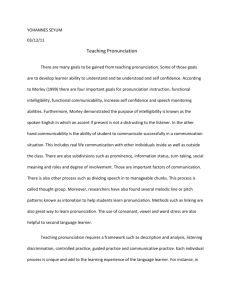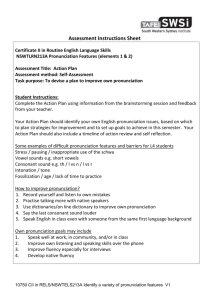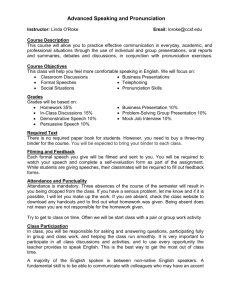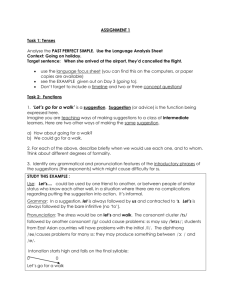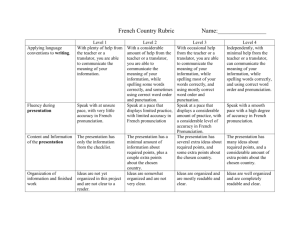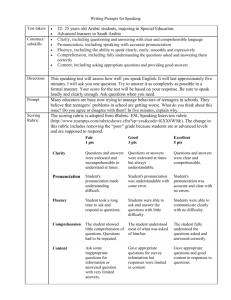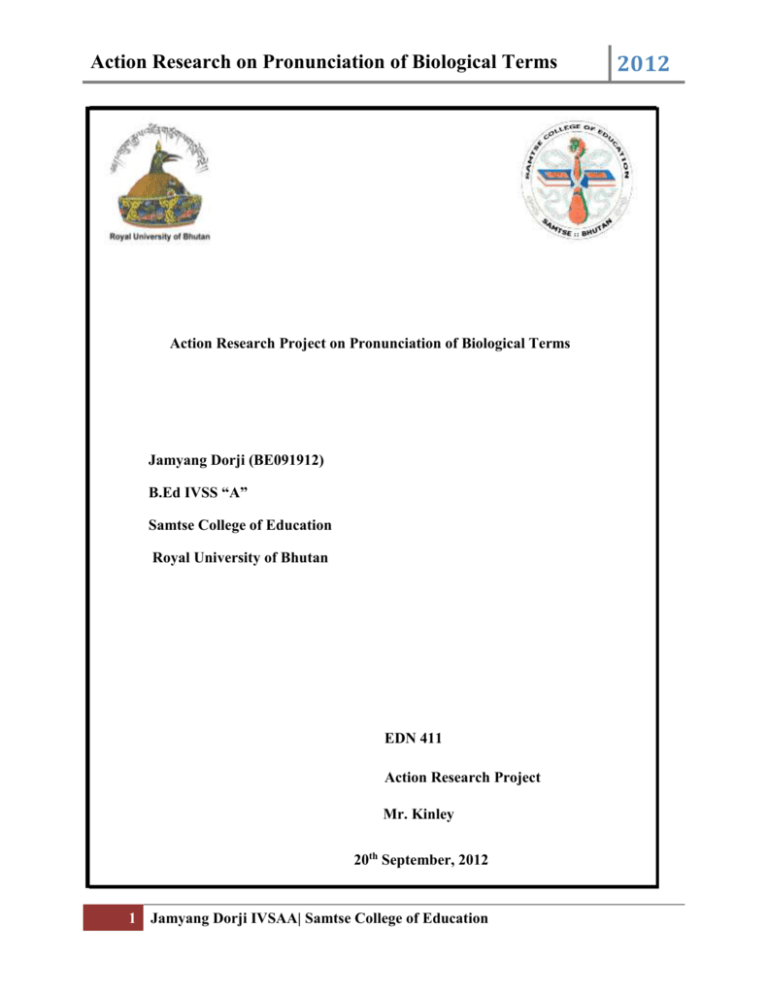
Action Research on Pronunciation of Biological Terms
Action Research Project on Pronunciation of Biological Terms
Jamyang Dorji (BE091912)
B.Ed IVSS “A”
Samtse College of Education
Royal University of Bhutan
EDN 411
Action Research Project
Mr. Kinley
20th September, 2012
1 Jamyang Dorji IVSAA| Samtse College of Education
2012
Action Research on Pronunciation of Biological Terms
2012
Samtse College of Education
Royal University of Bhutan
P.O. Box No. 329, Samtse, Bhutan
PLAGIARISM DECLARATION FORM
This form must be completed, signed and appended to each assignment you submit for marking in any form
(Print or electronically).
Student Name:
Jamyang Dorji
Student Number:
BE 091912
Module No & Title: EDN 411-Action Research Project
Assignment No & Title: 01, Action research on Pronunciation of Biological terms
Submission Date: 20th September, 2012
Section H2 of the Royal University of Bhutan’s Wheel of Academic Law provides the following definition of
academic dishonesty:
“Academic dishonesty may be defined as any attempt by a student to gain an unfair advantage in any assessment.
It may be demonstrated by one of the following:
Collusion: the representation of a piece of unauthorized group work as the work of a single candidate.
Commissioning: submitting an assignment done by another person as the student’s own work.
Duplication: the inclusion in coursework of material identical or substantially similar to material which has
already been submitted for any other assessment within the University.
False declaration: making a false declaration in order to receive special consideration by an Examination
Board or to obtain extensions to deadlines or exemption from work.
Falsification of data: presentation of data in laboratory reports, projects, etc., based on work purported
to have been carried out by the student, which have been invented, altered or copied by the student.
Plagiarism: the unacknowledged use of another’s work as if it were one’s own.
Examples are:
verbatim copying of another’s work without acknowledgement
paraphrasing of another’s work by simply changing a few words or altering the order of presentation,
without acknowledgement
ideas or intellectual data in any form presented as one’s own without acknowledging the source(s)
making significant use of unattributed digital images such as graphs, tables, photographs, etc. taken from
test books, articles, films, plays, handouts, internet, or any other source, whether published or unpublished
submission of a piece of work which has previously been assessed for a different award or module or at a
different institution as if it were new work
use of any material without prior permission of copyright from appropriate authority or owner of the
materials used”
Student Declaration
I confirm that I have read and understood the above definitions of academic dishonesty. I declare that I have not
committed any academic dishonesty when completing the attached piece of work.
Student’s Signature:
___ ___________________
Date of signing: 20/09/2012
2 Jamyang Dorji IVSAA| Samtse College of Education
Action Research on Pronunciation of Biological Terms
2012
Table of Contents
Action Research .............................................................................................................................. 4
Abstract ....................................................................................................................................... 4
Reconnaissance ........................................................................................................................... 5
Situational Analysis ................................................................................................................. 5
Country .................................................................................................................................... 5
University ................................................................................................................................ 5
Competence ............................................................................................................................. 6
Literature Review ........................................................................................................................ 6
What is pronunciation? ............................................................................................................ 7
Data Sets .................................................................................................................................... 10
Methodology ............................................................................................................................. 10
Baseline data collection tools .................................................................................................... 11
Baseline data Interpretation ....................................................................................................... 11
Likert scale ............................................................................................................................ 11
Spelling test/ Dictation test .................................................................................................... 12
Pronunciation test .................................................................................................................. 13
Intervention strategies ............................................................................................................... 14
Practice and modeling ........................................................................................................... 14
Scaffolding............................................................................................................................. 14
Post intervention data ................................................................................................................ 15
Questionnaire/ Likert scale analysis ...................................................................................... 15
Spelling/Dictation test ........................................................................................................... 17
Spelling test ........................................................................................................................... 18
Discussions ................................................................................................................................ 18
Conclusion................................................................................................................................. 19
Limitation .................................................................................................................................. 20
Recommendation ....................................................................................................................... 20
Acknowledgement ..................................................................................................................... 21
References ................................................................................................................................. 21
Appendix ................................................................................................................................... 22
3 Jamyang Dorji IVSAA| Samtse College of Education
Action Research on Pronunciation of Biological Terms
2012
Action Research
The action research was done onhowcan to improve Pronunciation of Biological in class IX/H
of Lungtenzampa Middle Secondary School?
Abstract
The researcher has done action research on “Improvement of Pronunciation of Biological
terminologies”. As a least advanced country in the scientific and biological field, we observed
that most of the Bhutanesestudents mispronounce the biological terms. For, the action research
has been carried to improve the pronunciation of biological terms. And to improve the correct
pronunciation of the biological terms, confident in pronouncing the biological terms and correct
spelling of the biological terms.
As a teacher there has been a greater responsibility to take appropriate measures to enhance the
pronunciation of the biological/scientific terms. Therefore, the action research was done in Class
IX/H in Lungtenzampa Middle Secondary School during teaching practice.
In the first week of the February month, 2011, the familiarization on action research was done
with school and students.The researcher also informed the school Principal and the concern class
about the action research. In the second week identified the AR Class. In 3rd and 4thweek
collection of the baseline data from the class involving methods like observations, class
test,likert scale notebook checking,etc. began(Refer all the Appendix). Then analyzed the
baseline data collected in the 5th week. Starting from 6th week to 12th week intervened the
classby:practicing,scaffoldingto the students, letting the students to read the given article on the
selected biological/scientificterms, conducting test on the writing and pronouncing biological
terms,let them practice, and modeling by the teacher. In the 13th week collection of the postintervention data began at the end of teaching practice during involving same tools as in baseline
data collection.
Critical Friends
Mr. ThoepagaNamgyel Dawa of B.EdIVSA (Eng/His) and Ms. ChekiWangmo of B.Ed IV SS
“B” (Maths/Phy) were my critical friends whom they have been helpful in carrying out the action
research and giving different approaches and suggestions for improvement. They too have taken
4 Jamyang Dorji IVSAA| Samtse College of Education
Action Research on Pronunciation of Biological Terms
2012
same module as researcher as part of professional development. Moreover my mentors have also
been very kind enough catering me full support and acceptance.
At the end,the researcher expects the students to pronounce the biological and scientific terms
fluently and correctly. They should be very confident in pronouncing biological and scientific
terms.They should beable to spell the biological terms correctly.
Reconnaissance
According to Rinchen (2009) as cited Maxwell (2003) developed three components of
reconnaissance viz: situational analysis, competent and literature review. He considered these
three components as requisite in action research development.
Situational Analysis
Country
The Kingdom of Bhutan is a small landlocked country in South Asia, located at the eastern end
of the Himalayas and bordered to the south, east and west by the Republic of India and to the
north by the People's Republic of China. Bhutan is separated from the nearby state of Nepal to
the west by the Indian state of Sikkim, and from Bangladesh to the south by West Bengal and
Assam.
The state religion is VajrayanaBuddhism and the population of 600,000 approximately. The
capital is Thimphu. After centuries of absolute monarchy, Bhutan held its first democratic
elections in March 2008. Bhutan is a member of the United Nations and the South Asian
Association for Regional Cooperation (SAARC) and hosted the sixteenth SAARC summit in
April 2010.
University
The Royal University of Bhutan (RUB), the only university in the country at present, has eleven
member colleges distributed across the country. Two of them are teacher training colleges: Paro
College of Education (PCE) and Samtse College of Education (SCE).
Samtse College of Education (SCE) was founded as the first teacher-training institute (TTI) in
the country of Bhutan in 1968. Our beloved late king, His Majesty Jigme Dorji Wangchuck
5 Jamyang Dorji IVSAA| Samtse College of Education
Action Research on Pronunciation of Biological Terms
2012
inaugurated the college on 29th May 1968 with an initial enrolment of 41 students. This historic
milestone in the country’s education history is observed as the College Foundation day every
year. Samtse College of Education is one of the premier institutions of learning in the country,
which provides training to Primary and Secondary teachers. It is also the center for a number of
in-service programs conducted during winter breaks. With the introduction of the Bachelor of
Education (B.Ed) Secondary program in 1983, the erstwhile TTI was renamed the National
Institute of Education (NIE). After becoming a member college of the Royal University of
Bhutan on June 22003, the NIE was once more renamed Samtse College of Education.
School
Lungtenzampa Middle Secondary School is one of the schools in the Thimphu. It is located to
the north-western part of Bhutan.
Competence
The researcher is a second year B.Ed student teacher in the Samtse College of Education taking
Biology and Chemistry as major electives. Hehave completed a research module as professional
development as separate module. And have an experience of doing a conventional researcher as
major assignment at College. With the research code of conduct and ethical issues related to the
educational and action research confident enough to carry out the action research. It has been
done action to improve pronunciation of biological terms in Class IX/D of Lungtenzampa
Middle Secondary School.
Competence of Students
My students have learnt science in lower classes but have never known about biology though it’s
a part of science. They were very new to the biology as subject and pronunciation of biological
terms in particular. For, I chose class nine class to carry out my action research to improve the
pronunciation of biological terms.
Literature Review
My literature review mainly what is pronunciation, its place and importance, and consists of
convention and some rules, and strategiestopronounce scientific, botanical, taxonomic and
biological (cited by few authors and writers) terms as follows:
6 Jamyang Dorji IVSAA| Samtse College of Education
Action Research on Pronunciation of Biological Terms
2012
What is pronunciation?
It is the way in which to make sound of a word or letter in a particular way especially with
reference to a standard format. (The Oxford English Reference Dictionary, 2005).
According to Hudson & Seedsman (2010) stated that
Many people are confused about the "correct" way to pronounce biological/botanical
names. Often people are insecure about this, and worry that they will "look stupid" if they
get the name "wrong”. Relax! The good news is there is NO "correct" way to pronounce
them! You may pronounce them any way you wish, and you will be just as "correct" as
any Ph.D. botanist. Yet there are few rules and conviction based to pronounce the
biological terms and other few scientific terms.
“Let me repeat—there is ABSOLUTELY, POSITIVELY, NO correct or official way to
pronounce scientific names!” (Hudson and Seedsman, 2010)
The author has designed the little pronunciation guides in the catalog for the genus names. But
they are just guides, and are in no way "correct" or "official" ways of saying them.
Here are some conventions that you might find useful for pronunciation. (Hudson and Seedsman,
2010):
The "ii" at the end of words like douglasii already mentioned—just say it like "ee".
Say "i" like "ee", not "eye".
Say "a" like "ah", not "ay".
Say "e" like "eh", not "ee".
"Ch" is usually said like a "k", not a ch, as in Pachycereus—"pa-kee-seer-ee-us", but sometimes
as a ch as in Lachenalia—"la-che-nal-ee-a".
7 Jamyang Dorji IVSAA| Samtse College of Education
Action Research on Pronunciation of Biological Terms
2012
According to Covington(2010) the pronunciations you hear in biology or astronomy class don’t
match the ones you learned from your Latin teacher, and guess what? That doesn’t mean they’re
wrong. They just reflect different periods in history.
Hayriye & Kayi, (2006) said “do not correct students' pronunciation mistakes very often while
they are speaking. Correction should not distract student from his or her speech.”
Rules and Convictions for English pronunciation of biological Latin or terms
Chandler(1889),Else(1967),Kelly (1986),havesetrules for the English Pronunciation of biological
Latin or termsincludingTaxonomic Names of Plants and Animalbasedon:
Letter Sounds:
The digraphs AE and OE are treated as the letter E.
LONG E as in me, we, be: anemia, caecum, aether, chamaeleon, larvae, vertebrae, foetus,
amoeba, phoenix.
SHORT E as in met, wet, set: aesthetic, aestivate, aestuaryhaemorrhage, oesophagus,
oestrogen.
Note the AE ending in group names: dog family, Canidae, ("CAN-id-ee" not "caniday"),
rose family, Rosaceae ("ro-SAY-see-ee"), cat subfamily, felinae ("fe-LINE-ee"), olive
tribe, oleeae ("ol-EE-ee-ee"), etc.
[AE and OE are often now written simply as E: anemia, fetus, amoeba, estrogen.]
C or G preceding AE or OE is pronounced as though followed by E:
Caesar = "seesar"
caecum = "seekum"
coelom = "seelom"
algae = "aljee"
CH is pronounced as K:chorus, echo, chrysanthemum.
TH as in thorax, thymus, thuja ("THOO-ja")
A final vowel is always voiced, as in flora, hero, Apollo.
fungi = "FUNJ-eye," i as in alibi
cocci = "COCKS-eye," i as in alibi
ovale = "oh-VAY-lee," e as in Simile, Daphne, hyperbole, anemone, Aphrodite, Chloe
8 Jamyang Dorji IVSAA| Samtse College of Education
Action Research on Pronunciation of Biological Terms
2012
difficile = "dif-ISS-il-ee," (as in the bacterial species name Clostridium difficile, C.
difficile -"see dif-ISS-il-ee"), e as in Daphne, hyperbole, anemone, Aphrodite, Chloe
stapes = "STAY-peez" e as in Achilles, meninges, diabetes
Some initial consonants are silent when followed by a consonant.
pterosaur = "TER-o-saur"
pseudopod = "SOO-do-pod"
pneuma = "NEW-ma"
gnathous = "NATH-ous"
phthegma = "THEG-ma"
chthamalus = "THAM-al-us"
ctenoid = "TEN-oid"
mnium = "NY-um"
tmema = "MEE-ma"
2. Words of more than 2 syllables are stressed on the second to last syllable IFthe vowel of that
syllable is followed by two or more consonants (making the vowel short).
Maxilla = "mac-ZILL-a"
Patella = "pa-TELL-a"
Chlorella = "Klo-RELL-a"
Lamella = "la-MELL-a"
Medulla = "med-ULL-a"
Laterallus = "lat-er-AL-us" (compare to lateralis, single l, below.)
Tyrannus = tir-ANN-us" (compare to montanus, single n, below.)
Narcissus = "nar-SIS-sus"
Canadensis = "ca-na-DEN-sis"
Macrophyllum = "mac-ro-FILL-um"
The Canadian psychologist Bandura (as cited in Berk, 2009), emphasized “modeling otherwise
known as imitation or observational learning a powerful source of development and learning.
The children acquire many skills through modeling” (Berk, 2009, p.19). According to Schütz
(2011), in the absence of a good model and without guidance, the learner will perceive, produce
and internalize sounds of the target language based on the native language sounds.The researcher
9 Jamyang Dorji IVSAA| Samtse College of Education
Action Research on Pronunciation of Biological Terms
2012
felt that such modeling otherwise known as imitation can be used as one of the intervention
strategies to improve the pronunciation of the intended research.
According to Vygotsky as cited in Berk (2009),
scaffolding- adjusting the support offered during a teaching session to fit the child’s
current level of performance. When the child has little notion of how to proceed, the
adults uses direct instruction, breaking the task down into manageable units, suggesting
strategies, and offering rationales for using them (p. 266).
Such technique of giving support when the responders have little notion on a problem can also
be applied for improvement.
According to Cruttenden (1997), the sounds of the language always being in process of change,
there have always been at any time disparities between the speed sounds of the younger and
older generation, the speech of the young is characterized by the old as slovenly and debased(7778).
Data Sets
1 Correct spelling of the scientific terms/ dictation test. The class test were conducted in
the beginning as well at the end via same intervention implied.
2 Likert scale(questionnaire). The same questionnaires were distributed for the baseline as
well as post data.
3 Correctness of the pronunciation(pronunciation test). To check the correctness of the
pronunciation the class test as part of assessment were conducted in the beginning and at
the end.
These are the areas focused to bring improvement of the research done.
Methodology
As the aims of the study the researcher has investigated the correct spelling and pronunciation of
biological terms. Questionnaires (Likert scale), observation, class test on spelling and dictation
served as tools and were implemented the mixed methods of research study.
The researcher developed a series of questionnaires and class tests according to the data sets
grounded to heighten and improve the pronunciation of biological terms. A brief description of
10 Jamyang Dorji IVSAA| Samtse College of Education
2012
Action Research on Pronunciation of Biological Terms
all questionnaires (Likert scale) and class tests scores have applied (refer Appendix:A, B, C, D,
E & F). The investigator circulated the questionnaires and analyzed test scores to keep and
enhance the pronunciation of biological terms.
Baseline data collection tools
The careful observations of the students on the pronunciation of biological terms while
answering the questions. By letting to read those terms indicated their weakness in pronouncing
the biological terms. For instance, many of them mispronounced the few biological terms like
mitochondria, fungi, botany, zoology, iris, stapes, etc.(refer Appendix: C)Moreover, many of
them are not so confident enough to pronounce those terms.
Base on the observation, the researcher has developed set of questionnaire containing three
items, distributed among the students and asked to tick mark base on their degree of agreement
against each item. The researcher also conducted the class test on dictation and pronunciation of
those selected biological terms from their text book (refer Appendix: A, B, C, D, E& F). In line
with the above mentioned tools it brings into the collection of three data sets the areas that can
bring improvement in pronouncing the biological terms.
Baseline data Interpretation
It was in 3rd and 4th week of teaching practice that collection of the baseline data from the class
involving methods like class test on spelling and pronunciation, likert scale, notebook checking,
etc. The analysis of the entire baseline data collected was done in the 5th week.
1. Likert scale
Sl.No. Items
SA
A
DA
SDA
1.
I can pronounce biological terms fluently
1
2
10
16
2.
I can write biological terms correctly
1
2
10
16
3.
I am confident in pronouncing biological terms
1
14
14
11 Jamyang Dorji IVSAA| Samtse College of Education
Action Research on Pronunciation of Biological Terms
2012
Likert Scale
50
45
40
35
30
25
20
15
10
5
0
S
t
d
s
'
N
o
.
14
14
3 I am confident in
pronouncing biological
terms
16
10
16
0
1 1
SA
1
2
10
1 I can pronounce
biological terms
fluently
2
A
DA
2 I can write biological
terms correctly
SDA
Degree of Agreements
After the identification of the action research class the questionnaire (Likert scale) were
distributed as it’s shown in the above graph. It reveals that the students are not very confident in
pronunciation and spelling of the biological terms. Base on the baseline data collected the
researcher decided to focus on their confident in pronunciation and spelling of the biological
terms.
2. Spelling test/ Dictation test
Sl no.
passed
Failed
pre-test marks 10.34
89.65
Pre-test marks
P
e
r
c
e
n
t
a
g
e
100
90
80
70
60
50
40
30
20
10
0
89.65
pre-test marks
10.34
passed
failed
12 Jamyang Dorji IVSAA| Samtse College of Education
Action Research on Pronunciation of Biological Terms
2012
The first data was collected by dictation test. The researcherdictated 20 biological terms from the
lesson taught and from lower classes as well. The above graph indicates that only 10.34% of
students passed and rest (89.65%) failed which is the vast difference between the failed and the
passed students. Therefore, the main focus was based on the baseline data collected to improve
the spelling of the biological terms.
3. Pronunciation test
Sl no.
Passed Failed
pre-test
marks
48%
52%
Pre-test marks
P
e
r
c
e
n
t
%
53%
52%
51%
50%
49%
48%
47%
46%
52%
pre-test marks
48%
passed
failed
The researcher conducted the spelling test of few biological terms from what they already have
learnedand what they have been learning. The baseline data graph above indicates that the
number of students who failed(52%) in the spelling test of the biological is bit higher than the
passed(48%) students. For, the researcher made the students to pronounce the selected biological
terms and make them pronounce those terms before the beginning of each lesson.
Conclusion of baseline data analysis
The baseline data collection and analysis reveals that the students are not very confident in
pronouncing biological terms. They are also very poor in spelling of the biological terms. They
also slightly lack the skills to pronounce the biologicalterms. On the evidence that the
researcher’s focus were on these three problems to improve their pronunciation.
13 Jamyang Dorji IVSAA| Samtse College of Education
Action Research on Pronunciation of Biological Terms
2012
Intervention strategies
With surveillance on the pronunciation and spelling of the biological terms and upon
investigating thepronunciation and spelling skillsof the biological terms. It was found very
essential to apply different strategies that could be able to ensure effective student learning
outcomesbasically in pronunciation of biological terms. Taking into the account of
students’weaknesses the intervention strategies were applied to bring improvement in the
pronunciation of certain biological terms base on cognitive levels. I applied the following
interventions:
Practice and modeling
The researcher could found that the most of the students mispronounced the biological terms
time and again. Intervenedthem to model and practice together base on the rules or conventions
given in the literature.The Canadian psychologist Bandura as cited in Berk,(2009), emphasized
“modeling otherwise known as imitation or observational learning a powerful source of
development and learning. The children acquire many skills through modeling” (Berk, 2009,
p.19). The researcher felt that such modeling otherwise known as imitation can be used as one of
the intervention strategies to improve the pronunciation of the intended research.
Scaffolding.
According to Vygotsky as cited in Berk (2009),
scaffolding- adjusting the support offered during a teaching session to fit the child’s
current level of performance. When the child has little notion of how to proceed, the
adults uses direct instruction, breaking the task down into manageable units, suggesting
strategies, and offering rationales for using them (p. 266).
Such technique of giving support when the responders have little notion on a problem can also
be applied for improvement. The researcher had used this intervention whenever the students
faced problem in pronunciation. Base on the rules and convictions the researcher applied the
technique of scaffolding to pronounce the biological terms.
3. Readingaloudto the class whenever they mispronounce the terms. The researcher pronounced
the biological terms aloud whenever they mispronounced. The students were also made to
pronounce aloud to the whole class. The mistakes were corrected by the teacher and scalfolded.
4. Letting the students to read out the selected scientific with the article provided.
14 Jamyang Dorji IVSAA| Samtse College of Education
Action Research on Pronunciation of Biological Terms
2012
Post intervention data
The post- data was gathered during the last week of May by administering the same tools used in
collecting pre-data. The survey questionnaires were circulated to the class and the response was
indeed good (refer Appendix: A & B). The class test on pronunciation and spelling of the
biological terms were also conducted at the end to check whether my intervention strategies were
appropriate to improve their pronunciation of the biological terms(refer Appendix: C & D).
There had been huge improvement in all of the three areas identified in the beginning. The predata are used as a comparative benchmark for the data collected during and after my intervention
(refer Fig. 1, 2, 3 & 4).
Graphical representation and Analysis of Data(Pre and Post)
All the data collected have been converted into the percentage for convenience. The data analysis
were also done base on the comparative studies of baseline and post intervention data as shown
in the following table:
Questionnaire/ Likert scale analysis
Likert Scale
14
50
S
t 40
d
30
s
' 20
N 10
o
0
.
14
16
10
0
1 1
SA
1
2 2
16
3 I am confident in
pronouncing biological
terms
2 I can write biological
terms correctly
10
A
DA
Degree of Agreements
1 I can pronounce
biological terms fluently
SDA
Fig. 1
15 Jamyang Dorji IVSAA| Samtse College of Education
Action Research on Pronunciation of Biological Terms
2012
Graphical representation of post intervention data
Likert Scale
50
10
S
t 40
d
30
s
20
N
o 10
.
0
15
8
21
9
5
4
4
SA
11
A
DA
0
SDA
3 I am confident in
pronouncing
biological terms
2 I can write
biological terms
correctly
1 I can pronounce
biological terms
fluently
Fig.2
The above two graphs are the two data for questionnaire/ likert scale. The baseline data reveals
that the degrees of agreements of the students in beginning are quite negative and low in each
item of the questionnaire indicating that they are not very confident in the pronunciation and the
spelling of the biological terms. However, with the intervention strategies like scaffolding,
practicing together and modeling by the researcher could enhance their pronunciation and
spelling, and confident in pronouncing the biological terms indicated by the Figure 2.The
Canadian psychologist Bandura (as cited in Berk, 2009), emphasized “modeling otherwise
known as imitation or observational learning a powerful source of development and learning.
The children acquire many skills through modeling” (Berk, 2009, p.19). It is the indication that
the intervention strategies are tools to improve the pronunciation of the biological terms.
16 Jamyang Dorji IVSAA| Samtse College of Education
Action Research on Pronunciation of Biological Terms
2012
Spelling/Dictation test
120
100
100
89.65
80
pre-test marks
60
post-test marks
40
20
10.34
0
0
passed
failed
Fig.3
This figure is the comparison of the baseline and post intervention data collected by the dictation
test of the biological terms (refer Appendix: C & D). The graph tells us that in the beginning
only 10.34% of the students could make it through and rest could not which is an indication that
the most of the students are very poor in spelling of the biological terms. Yet the post
intervention data indicates that the there is a huge differences between the post and pre data
where all the students could make it through (100%). The interventions like scaffoldings,
practice, modeling, and so on base on the literature are helpful to bring improvement in their
pronunciation. According to Schütz (2011), in the absence of a good model and without
guidance, the learner will perceive, produce and internalize sounds of the target language based
on the native language sounds. Therefore, it’s very vital to model and cater guidance for the
students.
17 Jamyang Dorji IVSAA| Samtse College of Education
Action Research on Pronunciation of Biological Terms
2012
Spelling test
percentage
Pronunciation Test
100%
90%
80%
70%
60%
50%
40%
30%
20%
10%
0%
86%
48%
52%
pre-test marks
post-test marks
14%
passed
failed
Fig.4
The graph is the comparison between baseline data and post intervention data collected on
spelling test of the biological terms(refer Appendix: E & F). Due to them being new to the
biology subject as new discipline in class IX seemed they are poor in the pronunciation of the
biological and even scientific terms. In the beginning they had so many problems in pronouncing
biological terms like mitochondria, chloroplast, fungi, zoology, botany, stapes and many
more(Refer Appendix: G).According to Vygotsky as cited in Berk (2009),
scaffolding- adjusting the support offered during a teaching session to fit the child’s
current level of performance. When the child has little notion of how to proceed, the
adults uses direct instruction, breaking the task down into manageable units, suggesting
strategies, and offering rationales for using them.
By scaffolding students when their ideas and knowledge over certain information, the support
and guidance would be the best way to enhance their ideas, knowledge, etc. Hudson and
Seedsman ( 2010 ), say "i" like "ay", not "eye" as in fungi and "Ch" is usually said like a "k", not
a ch, as in Pachycereus—"pa-kee-seer-ee-us" and mitochondria-“ my-to-kon-dri-ya”.
Discussions
From the comparative data analysis we can say that in the beginning the students were not very
fluent in pronunciation and spelling of the biological terms.Basically, the students were not very
confident to pronounce the biological terms. Their spelling and pronunciation of the biological
18 Jamyang Dorji IVSAA| Samtse College of Education
Action Research on Pronunciation of Biological Terms
2012
terms too were somehow not to the standard. However, the intervention strategies implied have
been valid as it could bring certain improvement.
However, according to Schütz (2011), in the absence of a good model and without guidance, the
learner will perceive, produce and internalize sounds of the target language based on the native
language sounds. Yet the scaffolding, modeling and practice, reading aloud base on the certain
rules and convictions would describe the way for improvement.
There have been a noticeable improvement in terms of their confident, speeling and
pronunciation of the biological terms scientific terms as well. None of the students were hesitant
in pronuncing the biological terms. There are also indiction that the spelling and pronunciation of
the biological terms had been improved drastically. For, the intervention strategies from
literature review are valid.
The questionnaire/ likert scale used indicates that the degree of agreements of the students in
each item in the post intervention are very positive (refer Appendix: B).The pronunciation of
the biological terms in post intervention too indicates improvementup to 90%. Moreover spelling
test of the post intervention data indicates the improvement is 100% (refer Appendix: D).
Therefore, the intervention strategies implied proved to be valid to improve the pronunciation of
the biological terms and spelling of the biological terms.
Conclusion
The researcher has been successful towards its intended and desired goals. The researcher is
optimistic that his action research could be helpful and applicable.
This action research concealed the researcher to understand students’ problems and needs in
pronunciation and spelling of the biological terms.It also highlights importance of teachers’ role
to bring improvement and to fortify the teaching learning process especially in the pronunciation
of the biological terms.
As indicated and analyzed, the baseline data and post intervention data, there have been greater
differences and improvement between pre and post data. The basic evidence for the improvement
could be the intervention strategies implied base on the literature review. The modeling and
imitation, scaffoldings and practice, reading aloud to the class whenever they mispronounce the
19 Jamyang Dorji IVSAA| Samtse College of Education
Action Research on Pronunciation of Biological Terms
2012
biological terms. The improvement and the positive curve of the graphs indicate that the
intervention strategies are can be applied and implied, and appropriate.
The sounds of the language always being in process of change, there have always been at any
time disparities between the speed sounds of the younger and older generation, the speech of the
young is characterized by the old as slovenly and debased Cruttenden (1997). Therefore, 100%
results were never ensured because of the dynamic process of the language in various nations.
Yet the more than 90% improvements are ensured.
Limitation
The researcher couldn’t cater the needs and help to every individuals during the implementation
of the intervention strategies and it might have let the learner’s feel that they have been ignored.
The data collections were not easy as the researcher has to be dual role player: teaching and
facilitating. Implementation of the intervention strategies were also difficult due to time
constrains. The researcher too faced challenges for the pronunciation as he is from science
background.
Recommendation
The current research was undertaken in a classroom during teaching learning as a facilitator of
learning, not as an authoritative source. Such way of teaching learning interaction could set the
conducive and free atmosphere in the classroom for interaction. This could be helpful to the
students’ confident level in classroom. The intervention strategies like practice, modeling,
scaffoldings, imitating and reading aloud to their mispronounced terms are effective in
improving the pronunciation of the biological terms.
The researcher suggests the students, subject teachers, biologists, school administration and
science organization as whole to administer and implement the intervention strategies for further
improvement of the pronunciation of the biological terms. However, there may be other
strategies as well yet the researcher too suggests as in this particular intervention strategies.
20 Jamyang Dorji IVSAA| Samtse College of Education
Action Research on Pronunciation of Biological Terms
2012
Acknowledgement
The researcher is very indebted to the following individuals for their directions, guidance,
assistance and contribution in the development of his action research:
Mr. Tashi Gyeltshen and Mr. Kinley, Module tutor, Samtse College of Education, for
enrichment, support and guidance.
Mrs. NamgayPem(Principal), Mrs. NamgayLhaden and Ms. JigmeEuden of Lungtenzampa
Middle Secondary School for their acceptance and guidance.
Class IX H students of Lungtenzampa Middle Secondary School for their cooperation.
The gratitude for them is beyond the horizons.
References
Berk, L.E.(2009).CHILD DEVELOPMENT (8th ed.). New Jersey, USA: Pearson Prentice Hall.
Covington,M.A.( March 31, 2010).Latin Pronunciation Demystified.Georgia:University of
Georgia
Cruttenden, A.(1997). Gimson’s Pronunciation of English(5thed.). New York: St Martin’s Press.
Else, G.F. 1967.The Pronunciation of Classical Names and Words in English.The Classical
Journal, 62:210-214.Retrieved 25th October 2010 from
http://nsdl.org/resource/2200/20100411231019948T.
Hudson, J. L. &Seedsman(2010).How to Pronounce Botanical Names.La Honda: California,
USA.
Kayi, H.(2006).Teaching Speaking: Activities to Promote Speaking in a Second Language.
Nevada,USA: University of Nevada Retrieved 25th October 2010 from
http://unr.edu/homepage/hayriyek
Kelly, H.A.(1986). Pronouncing Latin Words in English.Classical World, 80:33-37. Retrieved
25thOctober 2010 fromhttp://nsdl.org/resource/2200/20100411231019948T
The Oxford English Reference Dictionary. The Best in Single Volume Reference (2005). Walton
Street, Oxford: Oxford University Press
21 Jamyang Dorji IVSAA| Samtse College of Education
Action Research on Pronunciation of Biological Terms
2012
Appendix
Baseline data
Sl.No. Items
SA
A
DA
SDA
1.
I can pronounce biological terms fluently
1
2
10
16
2.
I can write biological terms correctly
1
2
10
16
3.
I am confident in pronouncing biological
1
14
14
terms
Appendix: A
Post intervention data
Sl.No. Items
SA
A
DA
SDA
1.
I can pronounce biological terms fluently
4
21
4
0
2.
I can write biological terms correctly
9
15
5
0
3.
I am confident in pronouncing biological 8
10
11
0
terms
Appendix: B
Baseline data (Dictation of biological terms)
Roll
Names
Marks (class test (20%))
1
BidanRai
0
2
Chandra Maya Galley
0
3
Chencho Dorji
1
4
Dechen Om
1
5
DechenPelden
5
6
DechenPeldon
2
7
DhanBdr
1
8
Dilli Ram Saru
1
No.
22 Jamyang Dorji IVSAA| Samtse College of Education
Action Research on Pronunciation of Biological Terms
9
Jigme
3
10
KhanduWangmo
2
11
KingaGyeltshen
1
12
Kinzang Dorji
2
13
LoteyJamtsho
4
14
NamgayZam
1
15
Pem Dorji
1
16
PemaLhaden
1
17
PemaLhamo
12
18
Samita
0
19
SherubGyeltshen
1
20
Singye Dorji
8
21
Sonam
0
22
SonamChoeki
13
23
SonamDhendup
2
24
SonamZangmo
2
25
Sunil
1
26
Thinley Wangdi
2
27
Tshering ChodenNamgyel
3
28
Tshering Lhamo
3
29
YuvrajTamang
2
Appendix: C
Total students: 29
Passed students: 3(10. 34 %)
Failed students: 26(89.65%)
23 Jamyang Dorji IVSAA| Samtse College of Education
2012
Action Research on Pronunciation of Biological Terms
2012
Post- intervention data (Dictation of biological terms)
Roll
Names
Marks (class test (20%))
1
BidanRai
15
2
Chandra Maya Galley
16
3
Chencho Dorji
11
4
Dechen Om
15
5
DechenPelden
12
6
DechenPeldon
12
7
DhanBdr
9
8
Dilli Ram Saru
16
9
Jigme
10
10
KhanduWangmo
13
11
KingaGyeltshen
16
12
Kinzang Dorji
12
13
LoteyJamtsho
17
14
NamgayZam
11
15
Pem Dorji
15
16
PemaLhaden
8
17
PemaLhamo
20
18
Samita
11
19
SherubGyeltshen
11
20
Singye Dorji
16
21
Sonam
11
22
SonamChoeki
20
23
SonamDhendup
15
24
SonamZangmo
14
25
Sunil
15
26
Thinley Wangdi
13
No.
24 Jamyang Dorji IVSAA| Samtse College of Education
Action Research on Pronunciation of Biological Terms
27
Tshering ChodenNamgyel
16
28
Tshering Lhamo
18
29
YuvrajTamang
19
Appendix: D
Total students: 29
Passed students: 29(100%)
Failed students: 0(0%)
Pronunciation Pre-test
Roll
Names
No.
Scores
(20%)
1
BidanRai
2
Chandra Maya Galley
3
ChenchoDorji
4
Dechen Om
5
DechenPelden
6
DechenPeldon
7
DhanBdr
8
Dilli Ram Saru
9
Jigme
10
KhanduWangmo
11
KingaGyeltshen
12
KinzangDorji
13
LoteyJamtsho
14
NamgayZam
15
PemDorji
16
Pema Lhaden
17
Pema Lhamo
18
Samita
25 Jamyang Dorji IVSAA| Samtse College of Education
2012
Action Research on Pronunciation of Biological Terms
19
SherubGyeltshen
20
SingyeDorji
21
Sonam
22
SonamChoeki
23
SonamDhendup
24
SonamZangmo
25
Sunil
26
Thinley Wangdi
27
Tshering ChodenNamgyel
28
Tshering Lhamo
29
YuvrajTamang
Appendix: E
Total students: 29
Passed students: 14(48%)
Failed students: 15(52%)
Pronunciation post-test
Roll
Names
No.
Scores
(20%)
1
BidanRai
2
Chandra Maya Galley
3
ChenchoDorji
4
Dechen Om
5
DechenPelden
6
DechenPeldon
7
DhanBdr
8
Dilli Ram Saru
9
Jigme
10
KhanduWangmo
26 Jamyang Dorji IVSAA| Samtse College of Education
2012
Action Research on Pronunciation of Biological Terms
11
KingaGyeltshen
12
KinzangDorji
13
LoteyJamtsho
14
NamgayZam
15
PemDorji
16
Pema Lhaden
17
Pema Lhamo
18
Samita
19
SherubGyeltshen
20
SingyeDorji
21
Sonam
22
SonamChoeki
23
SonamDhendup
24
SonamZangmo
25
Sunil
26
Thinley Wangdi
27
Tshering
ChodenNamgyel
28
Tshering Lhamo
29
YuvrajTamang
Appendix: F
Total students: 29
Passed students: 25 (86%)
Failed students: 4 (14%)
Biological terminologies for pronunciation test
1. Mitochondria
2. Fungi
3. Botany
27 Jamyang Dorji IVSAA| Samtse College of Education
2012
Action Research on Pronunciation of Biological Terms
4. Zoology
5. Iris
6. Chlorophyll
7. Cocci
8. Chloroplast
9. Androecium
10. Gynoecium
11. Pneumonia
12. Stapes
13. Carpel
Appendix: G
28 Jamyang Dorji IVSAA| Samtse College of Education
2012



